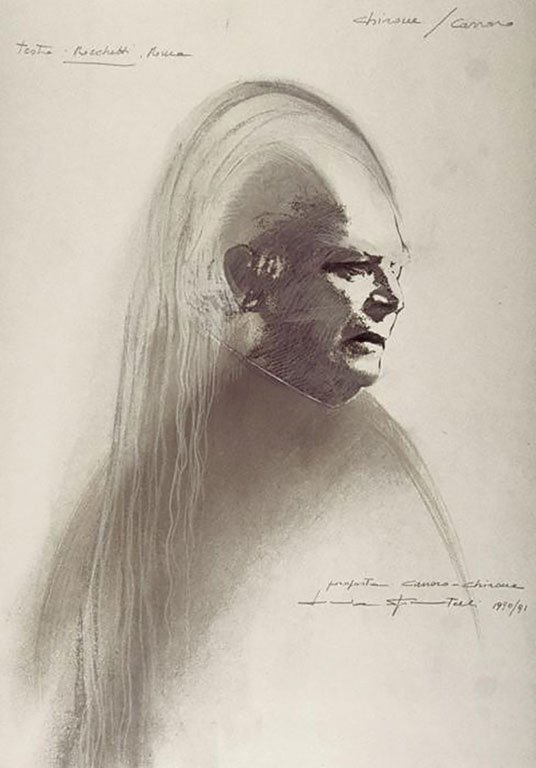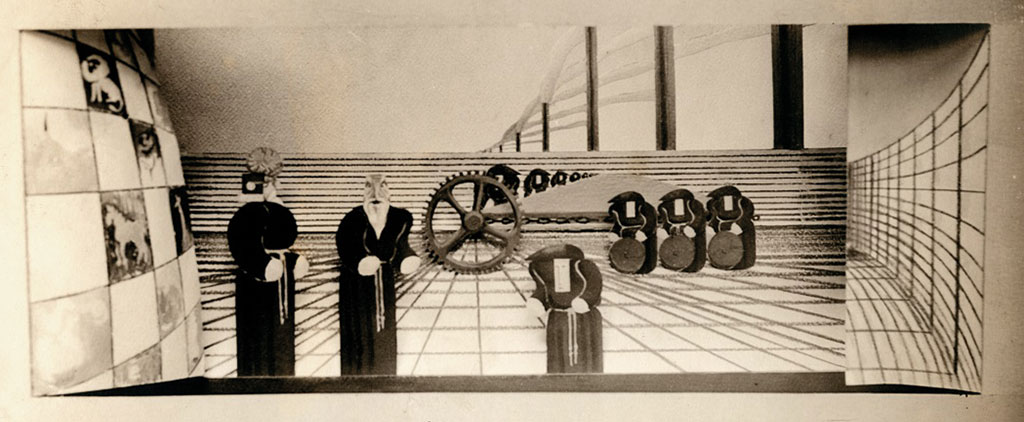Archives 2023
Nina Király: The Tragedy of Man or Mankind?
“Into this valley of perpetual dream,
Show whence I came, and where
I am, and why –
Pass not away upon the passing stream.”
(P. B. Shelley: The Triumph of Life)[1]
As can be seen from the bibliography[2] of translations compiled by Mihály Praznovszky and published in the volume titled Madách Színről színre (Madách Scene by Scene), there are basically three variations to encounter on the title of Madách’s The Tragedy of Man: one is “the tragedy of mankind” (in English, Polish, Russian, Romanian and Danish) or “the tragedy of the human” (in Norwegian, Italia and Russian) or the “human tragedy” (in Finnish); then the “sad human song” (in Armenian), “the destiny of man” (in Japanese); and the “vision of Adam” (in Hebrew). This is important to take into account when evaluating foreign stage renderings, because, in many cases, it determines whether Madách’s poem is to be interpreted as a philosophical (“Faust-like”) piece or a (cosmic) mystery play. In the preface to Jocelyn written in 1836, Lamartine makes sense of the essence of “mankind poems” (poeme d’humanité, Menschenheitsdichtung) thus: “The epic is neither heroic nor national any longer, but it is more: it is “human”; its subject is: the fate of “man”, the stages that the human spirit must go through in order to reach their goal on God’s road.”[3]
Poems of this type, such as Manfred and Cain by Byron, The Legend of the Ages by Hugo, Prometheus Unbound by Shelley as well as the works of the Three Bards of Polish Romantic literature, already a traditional parallel – Krasiński’s Nie-Boska komedia (The Un-divine Comedy), Słowacki’s Kordian and Mickiewicz’s Dziady (Forefathers’ Eve) –, constitute the European literary context in which The Tragedy of Man is usually analysed. However, if we examine the presence of the above “mankind poems” in French, English, German, Polish and Hungarian theatre history, that is to say, we are looking at what place they have occupied in the national repertoire during the past one and a half centuries, Madách’s The Tragedy will turn out to be the one which nearly matches the stage presence of Polish Romantic dramas. It certainly must not be forgotten though that censorship did not allow Polish Romantic dramas on stage for a long time. They could first prosper between the two world wars, then, with a few exceptions, they did not get played again until as long as 1956. Still, they were making repeated political waves even later, as it happened in the case of director Dejmek’s staging Mickiewicz at the National Theatre in Warsaw in 1968.
Therefore Madách’s work may be said to be the probably most played dramatic poem. Thanks to the performances of The Tragedy in Vienna (1934), Hamburg (1937) and Frankfurt (1940), the play did not remain unnoticed in Europe even before the Second World War. Unfortunately, neither the vision-oriented designs by Álmos Jaschik for the Prinzregenten-Theater in Munich (1931–32), nor János Horváth’s set and stage designs for the Teatro Reale dell’Opera in Rome and the Arena of Verona were realized. The dominant reading both in Hungary and abroad was mostly that of the “humanity’s history of ideas”, which seemed to justify János Arany’s remark on the poet’s weak point being that “his thinking is stronger than his imagination”. Scenographers usually tried to compensate for this “lack of imagination” by large historical tableaux, as the premiere of the work on Hungarian stage was realised in the Meiningen spirit of historical authenticity.[4] If The Tragedy was not regarded as “the tragedy of mankind” though, the main motif of Shelley’s poem quoted in the motto could apply most: “For what would it avail to bid thee gaze On the revolving world? What to bid speak Fate, Time, Occasion, Chance and Change? To these All things are subject but eternal Love.”(Act 2, Scene 4, P. B. Shelley: Prometheus Unbound)[5]

(source: Jaschik Álmos, a művész és pedagógus [Álmos Jaschik], Noran, 2002)
This is exactly what Giorgio Strehler was trying to do in his unfinished Faust project, which he thought of as a European venture par excellence. “It embraces the whole of European humanistic culture which is gathered together in Faust, and with Faust we are shown its greatness, its human value, the attainment of a synthesis of all that is beautiful, elevated, immeasurable (the good and the bad) that the »homo europeus« has given to the world” – wrote Strehler, who considers Faust “an ultimate final message to the world (the audience being a microcosm of the world) by means of the theatre”. Yet Strehler did not focus on large crowd scenes and spectacular solutions but on Faust’s state of mind and development, as he himself played the role of Faust at the age of seventy. Strehler insisted on Goethe’s full text, trying to break with Berlioz-Boito’s melodramatic and operatic rendering of Faust. When, in Strehler’s version, Faust reappears after his death, motionless and wrapped up in a white shroud, he reminds one of a larva or a chrysalis, which is intended to visually represent the generally omitted words of the heavenly choir: “Freudig empfangen wir / Diesen im Puppenstand” (“Joyously, we now welcome Him in a state of chrysalis”). Here, Goethe employs the traditional image of the soul as a butterfly, and depicts Faust in an intermediary stage before his salvation.

To Strehler, like in Shelley’s Prometheus, the end of the poem means “eternal love,” “the triumph of the feminine, and of the mothers and maternity”. There are only female figures present on the stage in the scene corresponding to the last lines in Faust – “dark-clad holy women who cover Faust with an enormous shroud – and he disappears into the mystical realm of the Mothers”. Strehler explained this scene thus: “Goethe defines for us his concept of immortality. Only through the mutation of life and its cyclical structure is there infinite regeneration of new life.”[6]
This incessant transformation is shown through the events of the Springtime of the Peoples in 1848 in the poem (Quidam) of the Polish poet, C. Norwid also, written in 1857 and published in 1863, that is almost simultaneously with the birth of Madách’s The Tragedy: “Sunt quidam de hic stanibus qui (There be some standing here) – Matthew 1628”[7]. “The hero is just someone – anyone – quidam! He does nothing, only seeks and longs for goodness, that is, as they say, he does nothing – but suffers a lot.” Incidentally, the poem – similarly to Madách’s – takes stock of a love affair which ended in disappointment, because one of the female characters – Sophia – represents Greek antiquity in which there is no room left for genuine emotions. Several analysts compare the fragmented structure to montage technique, which Norwid uses to look for the past in the present by alternating perspectives and planes, and represents the present by fragments of the past.[8] We can almost hear Lorán’s words in Madách’s play titled Csak tréfa (Just a Joke) from 1843–44: “Mi a jelen? – Perc szülte fuvalom, / Mely múlt s jövendőnek csókjából ered” (“What is present? – A minute-born breath of wind, / Which emerges from the kiss of past and future”).
It is a remarkable phenomenon abroad that Madách’s The Tragedy is not sought by professional theatres in the first place – but by drama school students, studio and children’s theatres as well as puppeteers. They do not see the motive of “dream about history” in this work, but the representation of the ethical issues of the time, Adam’s present-time peregrination, his desire for a just world order and, decisively, the fact that he is getting to know several religions and cultures in his ongoing quest. It was characteristic of the “happening” performance titled Madách-Annotations in Szabadka (Subotica), staged at the Népszínház (Popular Theatre) in Szabadka both in the Serbian and the Hungarian languages in 1985. The studies preparing for the production were published a year later, edited by Dragan Klaic and János Sziveri. In fact, this Madách project was made in the same spirit as Giorgio Strehler’s above-mentioned Faust.

(source: vajdmagy.blogspot.com)
Grégoire Callies, director of the Youth Theatre – TJP – in Strasbourg, had been getting ready to realise The Tragedy of Man for many years. He even visited Budapest to collect material in the archives of the Hungarian Theatre Museum and Institute, and in 1998 he created the production casting live actors as well as puppets. In his view, Madách’s drama is still extremely topical, “seeking the answer to the fundamental questions of existence, and above all, whether it is worth continuing the struggle”. And as exemplified by Strehler’s Faust production or Shelley’s aforementioned poem, the afflictions of the romantic couple become a symbol of eternal love.

(source: piccoloteatro.org)
Performances combining live actors and puppets have become quite widespread in recent times, which indicates a special revival of the language of theatre: at times the puppet is a means of alienation from the role, and at other times it is the contrary, being the link between actor, role and narration. However, in Faust, Mickiewicz’s Forefathers’ Eve and Madách’s The Tragedy, there are fairground scenes embedded in the text of the drama, which draw upon traditional folk “devils”, various Faust and Mephisto figures as well as popular scenes and fairy-tale texts related to them. These inserts are meant to alleviate tragic and cathartic moments, as it also happens in several Bergman films for instance. As we know, the initiator of adapting Madách to puppet theatre was Antal Németh. From Budapest, all through the creative process, he kept instructing Géza Blattner, who was living and working in Paris and headed the Arc-en-Ciel puppet theatre, as well as Sándor A. Tóth and the other puppeteers: Zsigmond Walleshausen, Tivadar Fried, Zoltán Olcsay Kiss, Zsigmond Kolos-vary (Kolozsvári), Károly Koffán among others. Naturally, the puppet production had to rely on an extremely shortened text only, as pointed out by Géza Blattner in his recollection, too: “With some modest Hungarian and French contribution, we had to go through a real egg dance so that we could put the one-hour mystery play across properly. There was no way to present the whole of The Tragedy, and therefore we compressed the dream scenes so that Lucifer was commenting on the vanishing centuries in front of a huge wheel of fortune. The actor turning the wheel incarnated human fate itself by pulling a mask over his face, with half of his body emerging from the stage opening and rotating the images fitted to the spokes from the bottom”.[9] The production was awarded the Grand Prix at the Paris World Exhibition, so the young artists from Strasbourg were already in possession of the French “tradition” created by the Hungarian puppeteers.

Committed to Hungarian literature and theatre in Italy, Giorgio Pressburger directed the drama exam performance of thirteen graduate students at the Academy of Dramatic Arts (Accademia Nazionale d’Arte Drammatica) in Rome at Eleonora Duse Theatre in 1989, which had a most significant Hungarian press coverage as well.
Internationally renowned Polish film director Krzysztof Zanussi was also impressed by the philosophical, moral, and religious issues in Madách’s work: his heroes’ struggles, search for the essence of existence and preservation of faith may best be expressed by the title of one of his films: Constans (The Constant Factor).
On his last visit to Budapest, he said he was planning to stage The Tragedy by Madách with Italian actors, as an open-air production in Migniato near Florence, where he had directed theatre productions on multiple occasions.
To my question about what he had found so appealing in Madách’s drama, he replied:

(source: Scene by Scene, 1999)
“I have long wanted to put Faust on stage. My wish has not been granted so far, but after Strehler and the controversy surrounding his project it does not seem timely. However, I see The Tragedy of Man between Goethe’s Faust and Mickiewicz’s Forefathers’ Eve. It has crossed my mind a few times to stage The Tragedy, but not having received a definite answer from the Italians yet, I cannot say anything specific. The Tragedy of Man offers many opportunities for a monumental open-air production. I have, of course, already cut the text and would like to stage it with a total of twelve actors. The piece gives an opportunity for extremely rich visual representation, since visions in a dream do not require a naturalistic setting. I am thinking of virtual scenery first and foremost, which can be achieved by the technical means of television. My open-air productions so far have also been characterized by multimedia visuals. Of course, I would not like to completely ignore the historical context, so I thought that paintings alluding to the particular periods of history would be projected on a canvas on the stage, with ever diminishing specificity and opening to cosmic vision. However, this would in no way be a representation of the tragedy of mankind, as suggested by the previous translations, but of the fate, the search and the suffering of »man“ on the thorny road, walking along which he would like to create an intelligent world. And although he loses his hope of achieving this several times, his faith is unbroken in his own power, and it is in accordance with the will of God. God has accomplished his perfect creation – machine is running – but history, which is the work of human hands – makes man face new and new ordeals, urging him on to create better and more perfect forms, according to the will of God. The fire of this struggle must not dwindle because it is the purpose of creation and existence.”[10]
English translation by Mrs. Durkó, Nóra Varga
Published in Hungarian:
Szcenárium, September 2018
[1] Nina Kiráy’s study was first published in 2002, in the second issue of Napút. This is an improved edited version of the text.
[2] Színről színre. Látványtervek Madách: Az ember tragédiájához. (Scene by Scene. Set Designs for Madách: The Tragedy of Man.) Budapest, Országos Színháztörténeti Múzeum és Intézet (Hungarian Theatre Museum and Institute), 1999. Appendix: Madách Imre: Az ember tragédiája a világ nyelvein (The Tragedy of Man in the Languages of the World). Compiled by Miháy Praznovszky; Madách Imre: Az ember tragédiája a színpadon (The Tragedy of Man on Stage). Literature Selection, 1983–1999. Compiled by Magdolna Both.
[3] Magyar, Bálint: Az ember tragédiája színpadi felfogása napjainkig. (Concepts of The Tragedy of Man on Stage to this Day) Budapest, 1963, p. 29
[4] However, János Szikora in his interview in Magyar Nemzet (Feb. 14, 2002, p. 15) talks about the visual values of The Tragedy, which can be read in Madách’s authorial instructions mainly: “Madách’s authorial instructions had almost the same inspiring effect on me as the text itself. They have opened my imagination and gave me a warning that what Madách writes should be taken seriously. That is why I have accepted a lot of his instructions and am even trying to implement them. For example, I am making an attempt to follow the writer’s wish in the Byzantine Black Sabbath, which is usually omitted. The apocalyptic image of »savage hordes are seen descending from the heights« in the authorial instructions has also inspired me to use visual representation.”
[5] Magyar, Bálint: op. cit. p. 33. http://www.lieder.net/get_text.html?TextId=49341
[6] Christopher Balme: Giorgio Strehler’s Faust Project. Világszínház ’98. Nyár (Summer), p. 65. https://books.google.hu/books?id=EY1HMT4tXMwC&pg=PA215&dq=Strehler+faust+synthesis+homo+europeus&hl=hu&sa=X&ved=0ahUKEwi9vsW3sYvgAhWRaQKHX_MBgEQ6AEIKjAA#v=onepage&q=Strehler%20faust%20synthesis%20homo%20europeus&f=false
[7] https://www.biblegateway.com/passage/?search=Matthew+16%3A28&version=KJV
[8] Cyprian Norwid: Pisma wybrane. Poematy. Warszawa, 1968, p. 127
[9] Mészáros, Emőke: Az ember tragédiája bábszínpadon. (The Tragedy of Man on Puppet Stage) Színháztudományi Szemle, 32. Bp., 1997, p. 64
[10] Interview with Krzysztof Zanussi, 27 February 2002. Here is just one example from the script instructions to the final scene of Zanussi’s A Year of the Quiet Sun: “They were in Colorado, Monument Valley. They were the same at dusk as when they met. Two lonely silhouettes against the background of metaphysical nature, of which Andrei Tarkovsky said that it was the window to eternity”. – Krzysztof Zanussi: Scenariusze filmowe. II. Warszawa 1985, p. 316
(02 May 2023)











